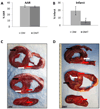Effect of thrombin fragment (TP508) on myocardial ischemia reperfusion injury in a model of type 1 diabetes mellitus
- PMID: 20837908
- PMCID: PMC2943853
- DOI: 10.1161/CIRCULATIONAHA.109.928374
Effect of thrombin fragment (TP508) on myocardial ischemia reperfusion injury in a model of type 1 diabetes mellitus
Erratum in
- Circulation. 2011 Dec 6;124(23):e780
Abstract
Background: We investigated the efficacy of novel thrombin fragment TP508 on ischemia-reperfusion injury using a porcine model of type 1 diabetes mellitus.
Methods and results: Alloxan-induced diabetic male Yucatan swine underwent 60 minutes of mid-left anterior descending coronary artery occlusion, followed by 120 minutes of reperfusion. Fifty minutes into ischemia, animals received either placebo (DM; n=8) or TP508 as a bolus of 1 mg/kg followed by infusion at 2.5 mg/kg per hour (DMT; n=8). Hemodynamic parameters and myocardial function were monitored. Monastryl blue/triphenyl tetrazolium chloride staining was used to assess sizes of the areas at risk and infarction. Coronary microvascular reactivity was measured and expression of cell survival and proapoptotic proteins quantified. Preoperative serum glucose values were similar between groups (309±57 mg/dL in DM versus 318±67 mg/dL in DMT; P=0.92). Infarct size was smaller in the TP508-treated group (5.3±1.9% in DMT versus 19.4±5.6% in DM; P=0.03). There was no statistically significant difference in global or regional left ventricular function between groups. Endothelium-dependent microvessel relaxation was moderately improved in the DMT group (P=0.09), whereas endothelium-independent relaxation was similar between groups. The expression of cell survival proteins Akt, phospho-p38, and mammalian target of rapamycin was higher in the areas at risk of DMT animals compared with DM animals (P<0.05), and expressions of proapoptotic glycogen synthase kinase 3β and caspase 3 were lower in the DMT group (P<0.05).
Conclusions: This study demonstrates that, in type 1 diabetic swine, TP508 reduces infarct size after ischemia-reperfusion. Thus, TP508 may offer a novel approach in cardioprotection from ischemia-reperfusion injury in diabetic patients.
Figures






Similar articles
-
Effect of thrombin fragment (TP508) on myocardial ischemia-reperfusion injury in hypercholesterolemic pigs.J Appl Physiol (1985). 2009 Jun;106(6):1993-2001. doi: 10.1152/japplphysiol.00071.2009. Epub 2009 Apr 16. J Appl Physiol (1985). 2009. PMID: 19372304 Free PMC article.
-
Thrombin fragment (TP508) decreases myocardial infarction and apoptosis after ischemia reperfusion injury.Ann Thorac Surg. 2009 Mar;87(3):786-93. doi: 10.1016/j.athoracsur.2008.12.021. Ann Thorac Surg. 2009. PMID: 19231390
-
Effect of dimerized thrombin fragment TP508 on acute myocardial ischemia reperfusion injury in hypercholesterolemic swine.J Pharmacol Exp Ther. 2010 Aug;334(2):449-59. doi: 10.1124/jpet.110.166348. Epub 2010 May 11. J Pharmacol Exp Ther. 2010. PMID: 20460385 Free PMC article.
-
Effect of hydrogen sulfide in a porcine model of myocardial ischemia-reperfusion: comparison of different administration regimens and characterization of the cellular mechanisms of protection.J Cardiovasc Pharmacol. 2009 Oct;54(4):287-97. doi: 10.1097/FJC.0b013e3181b2b72b. J Cardiovasc Pharmacol. 2009. PMID: 19620880
-
Susceptibility to myocardial ischemia reperfusion injury at early stage of type 1 diabetes in rats.Cardiovasc Diabetol. 2013 Sep 17;12:133. doi: 10.1186/1475-2840-12-133. Cardiovasc Diabetol. 2013. PMID: 24041262 Free PMC article.
Cited by
-
Intermedin protects against myocardial ischemia-reperfusion injury in diabetic rats.Cardiovasc Diabetol. 2013 Jun 18;12:91. doi: 10.1186/1475-2840-12-91. Cardiovasc Diabetol. 2013. PMID: 23777472 Free PMC article.
-
Different DOACs Control Inflammation in Cardiac Ischemia-Reperfusion Differently.Circ Res. 2021 Feb 19;128(4):513-529. doi: 10.1161/CIRCRESAHA.120.317219. Epub 2020 Dec 23. Circ Res. 2021. PMID: 33353373 Free PMC article.
-
Radiomitigation and Tissue Repair Activity of Systemically Administered Therapeutic Peptide TP508 Is Enhanced by PEGylation.AAPS J. 2017 May;19(3):743-753. doi: 10.1208/s12248-016-0043-7. Epub 2017 Jan 17. AAPS J. 2017. PMID: 28097629
-
Systemic administration of thrombin peptide TP508 enhances VEGF-stimulated angiogenesis and attenuates effects of chronic hypoxia.J Vasc Res. 2013;50(3):186-96. doi: 10.1159/000348250. Epub 2013 Apr 16. J Vasc Res. 2013. PMID: 23594718 Free PMC article.
-
Understanding the Pathophysiology and Challenges of Development of Medical Countermeasures for Radiation-Induced Vascular/Endothelial Cell Injuries: Report of a NIAID Workshop, August 20, 2015.Radiat Res. 2016 Aug;186(2):99-111. doi: 10.1667/RR14436.1. Epub 2016 Jul 7. Radiat Res. 2016. PMID: 27387859 Free PMC article.
References
-
- Jugdutt BI. Nitric oxide and cardioprotection during ischemia-reperfusion. Heart Fail Rev. 2002;7:391–405. - PubMed
-
- Ely SW, Berne RM. Protective effects of adenosine in myocardial ischemia. Circulation. 1992;85:893–904. - PubMed
-
- Kopecky SL, Aviles RJ, Bell MR, Lobl JK, Tipping D, Frommell G, Ramsey K, Holland AE, Midei M, Jain A, Kellett M, Gibbons RJ. A randomized, double-blinded, placebo-controlled, dose-ranging study measuring the effect of an adenosine agonist on infarct size reduction in patients undergoing primary percutaneous transluminal coronary angioplasty: the ADMIRE (AmP579 Delivery for Myocardial Infarction REduction) study. Am Heart J. 2003;146:146–152. - PubMed
-
- Marzilli M, Orsini E, Marraccini P, Testa R. Beneficial effects of intracoronary adenosine as an adjunct to primary angioplasty in acute myocardial infarction. Circulation. 2000;101:2154–2159. - PubMed
-
- Glenn KC, Frost GH, Bergmann JS, Carney DH. Synthetic peptides bind to high-affinity thrombin receptors and modulate thrombin mitogenesis. Pept Res. 1988;1:65–73. - PubMed
Publication types
MeSH terms
Substances
Grants and funding
LinkOut - more resources
Full Text Sources
Medical
Research Materials

